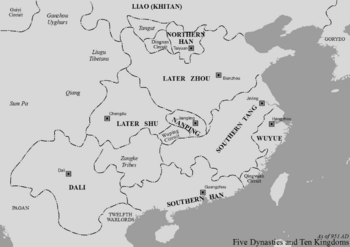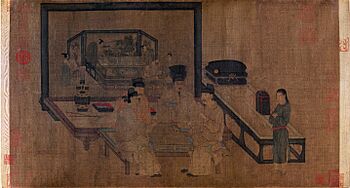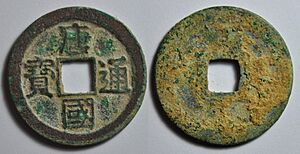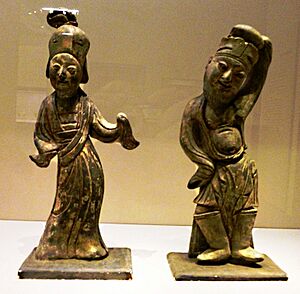Southern Tang facts for kids
Quick facts for kids
Tang
唐
|
|||||||||||||
|---|---|---|---|---|---|---|---|---|---|---|---|---|---|
| 937–976 | |||||||||||||

The Southern Tang territorial peak in 951
|
|||||||||||||
| Capital | Jinling, Guangling (briefly Nanchang) |
||||||||||||
| Common languages | Middle Chinese | ||||||||||||
| Government | Monarchy | ||||||||||||
| Emperor/King | |||||||||||||
|
• 937–943
|
Li Bian | ||||||||||||
|
• 943–961
|
Li Jing | ||||||||||||
|
• 961–976
|
Li Yu | ||||||||||||
| Historical era | Five Dynasties and Ten Kingdoms Period | ||||||||||||
|
• Overthrow of the Yang Wu dynasty
|
937 | ||||||||||||
|
• Assumption of the name "Tang"
|
939 | ||||||||||||
|
• Conquest of Min
|
945 | ||||||||||||
|
• Conquest of Ma Chu
|
951 | ||||||||||||
|
• Forced to cede Huainan and become a vassal of Later Zhou
|
958 | ||||||||||||
|
• Annexed by the Northern Song dynasty
|
976 | ||||||||||||
| Currency |
|
||||||||||||
|
|||||||||||||
| Today part of | China | ||||||||||||
The Southern Tang (Chinese: 南唐; pinyin: Nán Táng) was a state in China that existed during a time called the Five Dynasties and Ten Kingdoms period. It was located in southern China. The Southern Tang leaders said they were the true followers of the older, famous Tang dynasty.
Their main city was Jinling, which is in today's Jiangsu Province. At its biggest in 951, Southern Tang controlled all of modern Jiangxi and parts of other provinces like Anhui and Hubei.
Li Bian started the Southern Tang in 937. He took power from Emperor Yang Pu of the Wu state. Li Bian tried to keep peace with his neighbors. But his son, Li Jing, was more aggressive. He conquered the Min and Ma Chu states in 945 and 951.
Later, the Later Zhou dynasty attacked Southern Tang in 956 and won by 958. Li Jing had to give up land and his title of emperor. In 960, Southern Tang became a smaller state under the new Northern Song dynasty. The Song Emperor Emperor Taizu of Song later conquered Southern Tang completely in 975.
Contents
What Was the Southern Tang Called?

The name of the Southern Tang state and its rulers changed a few times. When Xu Zhigao (who later became Li Bian) first took power in 937, his state was called Great Qi.
However, many historical books started calling it "Tang" from the very beginning. This was because Li Bian wanted to connect his new state to the famous old Tang dynasty. People in the south felt a lot of respect for the Tang dynasty. So, in 939, Xu Zhigao officially changed his name to Li Bian and renamed his state to Great Tang. This made his state seem more important.
After Li Jing lost to the Later Zhou in 958, Southern Tang had to give up land. Li Jing also had to stop calling himself "emperor." The Later Zhou called him the "Ruler of the State of Jiangnan." But Li Jing still used "Ruler of Tang" for his government.
Li Yu, the last ruler, tried to show he was loyal to the Song dynasty. He used a more humble "Seal of Jiangnan" instead of "Seal of Tang." He also used the title "Ruler of the State of Jiangnan" until he surrendered in 976.
How the Southern Tang Began
Yang Xingmi was a powerful leader during the end of the Tang dynasty. He took control of a large area in what is now Jiangsu and Anhui. In 902, the Tang Emperor gave him the title of Prince of Wu. He died in 905, and his son Yang Wo took over.
In 907, the Tang dynasty officially ended. But the rulers of Wu, like Yang Wo and later Yang Pu, did not accept the new northern dynasties. They acted as independent rulers.
An orphaned child named Xu Zhigao was adopted by Yang Xingmi's general, Xu Wen. Xu Zhigao grew up to be very powerful. After Xu Wen died, Xu Zhigao gained control behind the Wu rulers. He planned to take the throne himself.
In 937, Yang Pu, the last Wu emperor, gave up his power to Xu Zhigao. This ended the Wu state.
Starting the New State
On November 11, 937, Xu Zhigao officially became the new ruler. He chose Jinling as his main capital. The old Wu capital, Guangling, became a secondary capital. His rule brought stability to the region.
On March 12, 939, Xu Zhigao changed his name to Li Bian. He also said he was related to the old Tang Imperial family. This helped him gain more respect and support.
Li Bian wanted a government run by educated officials, not just military leaders. Many experienced officials from the war-torn north moved to the more peaceful south. Li Bian especially liked scholars who knew about Confucianism. His government was known for being fair and attracting talented people.
Near the end of his rule, Li Bian chose his oldest son, Li Jing, to be his heir. Li Bian died in 943, and Li Jing became the new ruler.
Money and Trade
The Southern Tang and its neighbors were quite rich compared to the states in northern China. This was because the southern region had better farming. They also earned money from taxes as people had more to spend. Trading special goods like silk and salt also helped the economy.
Farmers in the lower Yangtze River area had improved their farming methods. They used better irrigation systems and grew a lot of rice. Silk production also became a big business, with farmers growing mulberry trees. In hilly areas, farmers specialized in tea or plants for textiles like hemp and ramie. These practices made Southern Tang's farming economy very strong.
Li Bian introduced new money policies to help the economy grow. He encouraged planting mulberry trees. Farmers who grew many trees received silk as a reward. Those who cleared new land for farming got money and didn't have to pay taxes for five years. These actions greatly increased farm production.
Later, under Li Jing, many wars cost a lot of money. Southern Tang had to pay large amounts of tribute to the Later Zhou and later to the Song dynasty. This hurt their economy. However, the Southern Tang still helped set the stage for a big economic boom in China later on.
Coins
During this period of constant war in the north, bronze coins became rare. So, Southern Tang and its neighbors made coins from clay, iron, or lead. These coins were for local use to keep valuable bronze coins from leaving the state.
Li Bian might have made a coin called Daqi Tongbao when the state was still called Qi. Li Jing later made different bronze coins like Datang Tongbao and Tangguo Tongbao. They looked similar but used different styles of Chinese calligraphy. Some new coins, like Yongtong Quanhuo, were meant to be worth ten copper coins, but people didn't trust them because of fakes. Older Tang dynasty coins, Kaiyuan Tongbao, were still used. Li Yu also minted coins with the same inscription in different writing styles.
The Southern Tang was the first in China to make special "vault protector coins." These were like good luck charms. They were hung in the Imperial Treasury to honor the Chinese God of Wealth and other gods.
Art and Culture
Artwork
Most Southern Tang court painters came from the Jiangnan area. This region likely had a strong art tradition before the Southern Tang began. While they painted traditional subjects, Southern Tang artists also created new types of art. These included landscape paintings, ink bamboo, and flower-and-bird paintings. They even painted marine life, which was new for Chinese art.
Dong Yuan and his students developed a unique style of landscape painting called the Southern School. This style influenced artists for hundreds of years. Detailed sculptures with pictures carved into them were also popular. You can still see examples at the Qixia Temple near Nanjing.
The Hanlin Academy was an art school founded in 943. It had many talented painters. The Southern Tang emperors were involved in running the academy and hiring new artists. When the Song dynasty conquered Southern Tang in 975, many of these skilled painters and poets were moved to the Song capital.
Four Treasures for Study
The Four Treasures of the Study were special items used for writing and painting in Southern Tang. They included brushes made by the Zhuge family, dragon tail inkstones, inksticks by Li Tinggui, and Pure Heart Hall paper. These items were highly valued by scholars even after the Southern Tang ended.
Brushes from the Zhuge family in Xuanzhou were very popular. Even the imperial family loved them. Later, famous Song scholars praised these brushes.
Dragon tail inkstones were made near Wuyuan. Li Jing even set up a special office to manage their production. Skilled workers who made these inkstones received salaries. These inkstones were often given as gifts among scholars. The most prized ones had golden specks and were called jinxing yan.
A famous inkstick maker named Xi Nai moved to Shezhou to escape the wars. His son, Xi Chao, used Huangshan pine trees to make high-quality inksticks. Xi Chao's son, Xi Tinggui, was so skilled that Emperor Li Yu gave him the imperial family name, Li. So, his inksticks became known as Li Tinggui Ink.
Pure Heart Hall paper was another important item. It was made by skilled craftsmen in Jiangnan. This special paper was used for official royal announcements. Only important officials were allowed to use it for government documents. It was so precious that it was not sold in markets. After the Song dynasty took over, many fake Pure Heart Hall papers appeared because the secret to making the real ones was lost.
Relations with Other States
Li Bian, the first Southern Tang ruler, wanted to keep peace with his neighbors. He sent ambassadors to states like Jingnan, Min, Southern Han, and Wuyue to announce his rule. These states sent their own envoys to congratulate him.
Li Bian believed that attacking other states would hurt his own people. He said, "When I leave other people alone and in peace, then my people will be in peace as well." He wanted to wait for the right moment to unite China peacefully.
However, his son Li Jing was more interested in expanding his territory. He conquered the Min Kingdom in 945 and Chu in 951. But these wars were costly and often led to problems.
Northern Dynasties
The term "Five Dynasties" refers to the states in northern China that were believed to hold the "Mandate of Heaven," meaning they had the right to rule all of China.
Southern Tang was rich, but its army was mostly infantry and naval forces, not cavalry. This made it hard for them to fight in the open plains of the north, where cavalry was strong.
Later Jin
In 936, the Later Jin dynasty was formed in the north. In 938, a Southern Tang official suggested killing a northern visitor to start a war between Later Jin and the Khitans. The killing happened, but it didn't cause a war.
In 940, Southern Tang tried to support a rebellion in Later Jin territory. Li Bian sent an army north, but his commanders looted a city and then retreated. This upset Li Bian, who wanted peace.
Later Han
In 947, the Later Han dynasty was established in the north. In 948, a rebel leader asked Southern Tang for help against Later Han. Li Jing sent an army, but they were defeated and had to retreat.
Southern Tang tried to restart trade with Later Han, but they refused. There were more border conflicts. Southern Tang tried to take territory across the Huai River but failed again.
Later Zhou
In 951, the Later Zhou emperor said he wanted peace with Southern Tang. This allowed Southern Tang to conquer Chu without interference. But this peace didn't last.
In 955, the Later Zhou emperor Chai Rong decided to attack Southern Tang. Southern Tang's defenses were weak. Later Zhou forces crossed the Huai River and invaded. The city of Shouchun was surrounded for 14 months. Southern Tang's military leaders made many mistakes. By 958, Shouchun fell, and the Later Zhou army advanced towards the capital, Jinling. Southern Tang had to give up all land north of the Yangtze River and become a vassal state to Later Zhou.
Southern Kingdoms
The rulers of the "Ten Kingdoms" in the south didn't necessarily believe China had to be united under one ruler. They often claimed to be emperors themselves but still had diplomatic relations with each other.
Min
In 943, the Min Kingdom was divided by a rebellion. Southern Tang invaded in 945 and captured most of Min territory. However, the wealthy port city of Fuzhou was taken by the Wuyue state, a rival of Southern Tang. This war was very expensive for Southern Tang.
Wuyue
The Wuyue state often had conflicts with Southern Tang. Wuyue protected itself by being a vassal to the northern dynasties. This meant if Southern Tang attacked Wuyue, the northern states might attack Southern Tang.
In 941, the Wuyue capital was destroyed by fires. Southern Tang military leaders wanted to invade, but Li Bian refused, saying, "How can I take advantage of the calamity of other people?" Instead, he sent food to help the people of Hangzhou.
Wuyue helped defeat Southern Tang during the Min conquest. Wuyue also helped the Later Zhou invade Southern Tang in 956. When the Song dynasty attacked Southern Tang, the Wuyue ruler joined the Song forces.
Chu
In 951, the ruler of Chu became a vassal of Southern Tang. Southern Tang sent an army to the Chu capital and took control. But the Southern Tang rule was unpopular, and rebellions broke out. The Southern Tang army had to retreat, and their control over Chu ended in an embarrassing defeat.
Southern Han
The Southern Han state had agreements with Southern Tang. In 951, Southern Han took advantage of Southern Tang's war in Chu and invaded to take control of Lingnan. Southern Tang's counterattack failed, and Southern Han kept its new lands.
Liao Dynasty

The Khitan, who later formed the Liao dynasty, were important partners for Southern Tang. They helped balance the power of the northern Chinese states. Li Bian and the Khitan ruler even called each other brothers.
In 938, Khitan envoys brought many sheep and horses to Southern Tang. In return, Southern Tang gave them medicine, silk, and tea. A painting called "Two Qidan Bringing Tribute" was made to celebrate this important event.
It was hard for Southern Tang and Khitan to contact each other because northern states were in the way. So, they developed a sea route for trade and diplomacy.
In 947, the Khitan ruler offered Li Jing control of northern China. Li Jing refused, perhaps because Southern Tang felt culturally superior. However, Li Jing asked the Khitan ruler to let Southern Tang repair the old Tang tombs. The request was denied, which angered Li Jing.
Later, when the Later Zhou attacked Southern Tang, Li Jing asked the Liao dynasty for help. But the Liao emperor was not interested in Chinese affairs. Liao-Southern Tang relations ended after a Liao envoy was killed by spies during a visit to Southern Tang.
Goryeo
In 936, Taejo united the Korean Peninsula under the Goryeo state. Goryeo sent tribute missions to Southern Tang in 938 and 940, bringing local goods. Southern Tang likely valued Goryeo as a way to threaten the Khitans.
The End of Southern Tang
By the end of Li Jing's rule, Southern Tang was becoming weaker. His wars had been costly and often ended badly. After losing to the Later Zhou from 955 to 958, Southern Tang had to give up a lot of land and pay tribute. The state became much smaller and less important.
In February 960, Zhao Kuangyin started the Song dynasty. Li Jing quickly sent envoys to show his loyalty to the new Song emperor. The Song emperor wanted to unite all of China. He left Southern Tang alone for a while in exchange for large amounts of tribute. In August 961, Li Jing died, and his son Li Yu became the new ruler.
Li Yu tried to keep his state somewhat independent, but it came at a high cost. He had to pay huge amounts of gold, silver, and silk to the Song dynasty. Since Southern Tang was much smaller, it was hard to meet these demands. New Song tax rules in 964 made things even worse.
After conquering other southern states, the Song emperor turned his attention to Southern Tang. Li Yu was repeatedly called to the Song court but pretended to be sick. Finally, in November 974, the Song emperor sent an army to conquer Southern Tang.
The Song army easily crossed the Yangtze River. They defeated a Southern Tang army and reached the capital, Jinling, in March 975. Li Yu had not prepared good defenses. The capital was surrounded in April.
In January 976, Li Yu surrendered outside his palace. He and his officials knelt before the Song general. Li Yu was taken to the Song capital in February. The Song dynasty officially took over Southern Tang. In 978, Li Yu died.
Rulers
| Temple Names | Personal Names | Period of Reigns | Reign periods and dates |
|---|---|---|---|
| Liezu (烈祖 Liè Zǔ) | 李昪 Lǐ Biàn | 937–943 | Shengyuan (昇元 Shēng Yuán) 937–943 |
| Yuanzong (元宗 Yuán Zōng) | 李璟 Lǐ Jǐng | 943–961 | Baoda (保大 Bǎo Dà) 943–958 Jiaotai (交泰 Jiāo Tài) 958 Zhongxing (中興 Zhōng Xīng) 958 |
| Houzhu (後主 Hòu Zhǔ) | 李煜 Lǐ Yù | 961–975 | (Under Li Yu, the Southern Tang did not have its own reign periods) |
Southern Tang and Wu Rulers Family Tree
| Southern Tang and Wu | ||||||||||||||||||||||||||||||||||||||||||||||||||||||||||||||||||||||||||||||||||||||||||||||||||||||||||||||||||||||||||||||||||||||||||||||||||||||||||||||||||||||||||||||||||||||||||||||||||||||||||||||||||||||||||||||||||||||||||||||||||||||||||||||||||||||||||||||||||||||||||||||||||||||||||||||||||||||||||||||||||||||||||||||||||||||||||||||||||||||||||||||||||||||||||||||||||||||||||||||||||||||||||||||||||||||||||||||||||||||||||||||||||||||||||||||||||||||||||||||||||||||||||||||||||||||||||||||||||||||||||||||||||||||||||||||||||||||||||||||||||||||||||||||||||||||||||||||||||||||||||||||||||||||||||||||||||||||||||||||||||||||||||||||||||||||||||||||||||||||||||||||||||||||||||||||||||||||||||||||||||||||||||||||||
|---|---|---|---|---|---|---|---|---|---|---|---|---|---|---|---|---|---|---|---|---|---|---|---|---|---|---|---|---|---|---|---|---|---|---|---|---|---|---|---|---|---|---|---|---|---|---|---|---|---|---|---|---|---|---|---|---|---|---|---|---|---|---|---|---|---|---|---|---|---|---|---|---|---|---|---|---|---|---|---|---|---|---|---|---|---|---|---|---|---|---|---|---|---|---|---|---|---|---|---|---|---|---|---|---|---|---|---|---|---|---|---|---|---|---|---|---|---|---|---|---|---|---|---|---|---|---|---|---|---|---|---|---|---|---|---|---|---|---|---|---|---|---|---|---|---|---|---|---|---|---|---|---|---|---|---|---|---|---|---|---|---|---|---|---|---|---|---|---|---|---|---|---|---|---|---|---|---|---|---|---|---|---|---|---|---|---|---|---|---|---|---|---|---|---|---|---|---|---|---|---|---|---|---|---|---|---|---|---|---|---|---|---|---|---|---|---|---|---|---|---|---|---|---|---|---|---|---|---|---|---|---|---|---|---|---|---|---|---|---|---|---|---|---|---|---|---|---|---|---|---|---|---|---|---|---|---|---|---|---|---|---|---|---|---|---|---|---|---|---|---|---|---|---|---|---|---|---|---|---|---|---|---|---|---|---|---|---|---|---|---|---|---|---|---|---|---|---|---|---|---|---|---|---|---|---|---|---|---|---|---|---|---|---|---|---|---|---|---|---|---|---|---|---|---|---|---|---|---|---|---|---|---|---|---|---|---|---|---|---|---|---|---|---|---|---|---|---|---|---|---|---|---|---|---|---|---|---|---|---|---|---|---|---|---|---|---|---|---|---|---|---|---|---|---|---|---|---|---|---|---|---|---|---|---|---|---|---|---|---|---|---|---|---|---|---|---|---|---|---|---|---|---|---|---|---|---|---|---|---|---|---|---|---|---|---|---|---|---|---|---|---|---|---|---|---|---|---|---|---|---|---|---|---|---|---|---|---|---|---|---|---|---|---|---|---|---|---|---|---|---|---|---|---|---|---|---|---|---|---|---|---|---|---|---|---|---|---|---|---|---|---|---|---|---|---|---|---|---|---|---|---|---|---|---|---|---|---|---|---|---|---|---|---|---|---|---|---|---|---|---|---|---|---|---|---|---|---|---|---|---|---|---|---|---|---|---|---|---|---|---|---|---|---|---|---|---|---|---|---|---|---|---|---|---|---|---|---|---|---|---|---|---|---|---|---|---|---|---|---|---|---|---|---|---|---|---|---|---|---|---|---|---|---|---|---|---|---|---|---|---|---|---|---|---|---|---|---|---|---|---|---|---|---|---|---|---|---|---|---|---|---|---|---|---|---|---|---|---|---|---|---|---|---|---|---|---|---|---|---|---|---|---|---|---|---|---|---|---|---|---|---|---|---|---|---|---|---|---|---|---|---|---|---|---|---|---|---|---|---|---|---|---|---|---|---|---|---|---|---|---|---|---|---|---|---|---|---|---|---|---|---|---|---|---|---|---|---|---|---|---|---|---|---|---|---|---|---|---|---|---|---|---|---|---|---|---|---|---|---|---|---|---|---|---|---|---|---|---|---|---|---|---|---|---|---|---|---|---|---|---|---|---|---|---|---|---|---|---|---|---|---|---|---|---|---|---|---|---|---|---|---|---|---|---|---|---|
|
– Wu emperors; – Southern Tang emperors
|
||||||||||||||||||||||||||||||||||||||||||||||||||||||||||||||||||||||||||||||||||||||||||||||||||||||||||||||||||||||||||||||||||||||||||||||||||||||||||||||||||||||||||||||||||||||||||||||||||||||||||||||||||||||||||||||||||||||||||||||||||||||||||||||||||||||||||||||||||||||||||||||||||||||||||||||||||||||||||||||||||||||||||||||||||||||||||||||||||||||||||||||||||||||||||||||||||||||||||||||||||||||||||||||||||||||||||||||||||||||||||||||||||||||||||||||||||||||||||||||||||||||||||||||||||||||||||||||||||||||||||||||||||||||||||||||||||||||||||||||||||||||||||||||||||||||||||||||||||||||||||||||||||||||||||||||||||||||||||||||||||||||||||||||||||||||||||||||||||||||||||||||||||||||||||||||||||||||||||||||||||||||||||||||||







